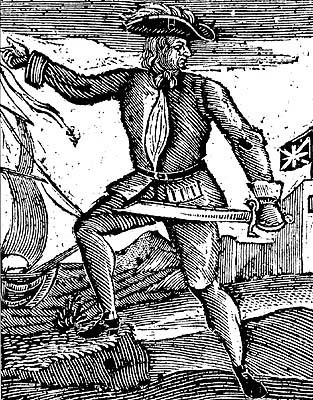
Bartholomew Roberts, born John Roberts, was a Welsh pirate who was, measured by vessels captured, the most successful pirate of the Golden Age of Piracy. During his piratical career, he took over 400 prize ships, although most were mere fishing boats. Roberts raided ships off the Americas and the West African coast between 1719 and 1722; he is also noted for creating his own pirate code, and adopting an early variant of the Skull and Crossbones flag.

Stede Bonnet was an English pirate who was known as the Gentleman Pirate because he was a moderately wealthy landowner before turning to a life of crime. Bonnet was born into a wealthy English family on the island of Barbados, and inherited the family estate after his father's death in 1694. Despite his lack of sailing experience, Bonnet decided he should turn to piracy in the spring of 1717. He bought a sailing vessel, the Revenge, and travelled with his paid crew along the Eastern Seaboard of what is now the United States, capturing other vessels and burning other Barbadian ships.

Edward Low was a pirate of English origin during the latter days of the Golden Age of Piracy, in the early 18th century. Low was born into poverty in Westminster, London, and was a thief from an early age. He moved to Boston, Massachusetts, as a young man. His wife died in childbirth in late 1719. Two years later, he became a pirate, operating off the coasts of New England and the Azores, and in the Caribbean.

George Lowther was an English pirate who, although little is known of his life, was reportedly active in the Caribbean and Atlantic during the early 18th century. His first mate was Edward Low.

Charles Vane was an English pirate who operated in the Bahamas during the end of the Golden Age of Piracy.

Howell Davis, also known as Hywel and/or Davies, was a Welsh pirate. His piratical career lasted just 11 months, from 11 July 1718 to 19 June 1719, when he was ambushed and killed. His ships were the Cadogan, Buck, Saint James, and Rover. Davis captured 15 known English and French ships.

John Evans was a Welsh pirate who had a short but successful career in the Caribbean.
Christopher Moody was a pirate as a member of Bartholomew Roberts' crew but was never a captain in his own right. He is best known not for his own actions but for a popular Jolly Roger flag mis-attributed to him as well as for later authors confusing him with unrelated pirate William Moody.
John Fenn was an early 18th-century English pirate who sailed with Captain Bartholomew Roberts and later had a brief partnership with Thomas Anstis.
See also 1718 in piracy, 1720 in piracy, 1719 and Timeline of piracy.
See also 1719 in piracy, 1721 in piracy and Timeline of piracy.
Charles Harris was an English pirate active in the 1720s. He is best known for his association with George Lowther and Edward Low.
See also 1721 in piracy, 1723 in piracy and Timeline of piracy.

John Phillips was an English pirate captain. He started his piratical career in 1721 under Thomas Anstis, and stole his own pirate vessel in 1723. He died in a surprise attack by his own prisoners. He is noted for the articles of his ship, the Revenge, one of only a few complete sets of pirate articles to survive from the so-called Golden Age of Piracy.

The Battle of Cape Fear River, also known as the Battle of the Sandbars, was fought in September 1718 between two sloops from the Province of South Carolina led by William Rhett and a group of pirate ships under the command of Stede Bonnet. Rhett's sloops defeated the pirates in the Cape Fear River estuary which led to Bonnet's eventual execution by hanging in Charleston, South Carolina.

The Battle of Cape Lopez was fought in early 1722 during the Golden Age of Piracy. A Royal Navy ship of the line under the command of Captain Chaloner Ogle defeated the pirate ship of Bartholomew Roberts off the coast of Gabon, West Africa.
Montigny La Palisse was a French pirate best known for his association with Bartholomew Roberts.
Richard Glover was a pirate and slave-trader active in the Caribbean and the Red Sea in the late 1690s.
Richard Shipton was a pirate active in the Caribbean, best known for sailing alongside Edward Low and Francis Spriggs. In 1723 Shipton was elected captain of Merry Christmas, and he subsequently captained ships such as Royal Fortune, York, and John and Mary. Forced to beach his vessel on western Cuba by pirate hunters, in early 1726, he was found ashore in his bed and presumed to have died shortly afterwards.
Brigstock Weaver was an English pirate active in the Caribbean. He is best known for his association with fellow pirates Thomas Anstis and Bartholomew Roberts.













